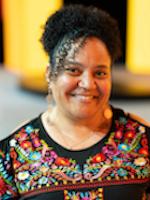



Participants will experience varying activities to engage students with music, its lyrics, and its historical context to the present day.
Participants will participate in a live Nearpod lesson that allows for annotation of lyrics, drawing to show understanding, and opportunities to reflect on their own practice with culturally responsive resources.
A Nearpod Live Lesson, facilitated by the presenters, will
* encourage participants to share their thoughts, annotate lyrics, and share their reflections on a platform (Jamboard and Padlet)for all to read, process, and comment.
* sketchnote their feelings as they listen to a song.
* reflect on all the activities, ideas, and lingering questions by completing a WOW-HOW-NOW.
Students interacted in a learning space that valued their voices. Students learned from each other about what thoughts, connections, and questions they pondered as they closely read music lyrics. Prior knowledge was changed, confirmed, and/or challenged for students by each other and further interactions with primary sources, including musical lyrics. Topics that included social justice, historical consequences, and equity were often connected and sparked following students’ annotating lyrics using close reading tactics.
1. Reflect on the use of music as an instructional tool (8 mins)
2. Discuss why should students interact and closely read musical lyrics (8 mins)
3. Review the importance of using Primary Sources (8 mins)
4. Experience two different ways to listen and engage with a song and it’s lyrics (30 mins)
5. Review additional tips for more listens and close reads (8 mins)
6. Briefly chat and learn about another cultural responsive song and lyrics (10 mins)
7. Brainstorm and share additional activities (18 mins)
* Strategies for Close Reading by Kylene Beers and Bob Probst - “The essential element in rigor is engagement. If students are to read rigorously they must be committed to understanding some intriguing character, to solving some problem, to figuring out what a writer believes and how those thoughts compare with their own.” Kylene Beers and Bob Probst
* Dr. Rudine Sims Bishop videos - https://youtube.com/playlist?list=PLLxDwKxHx1yLH9i0wFT21xxYSSMjS4KGi
* Cultivating Genius - Dr. Gholdy Muhammad
* I have used this strategy in my classroom for more than 10 years. Students are connected, feel valued because their voices, opinions, and thoughts are shared and honored, and students can debate with evidence to get their point across to their peers.